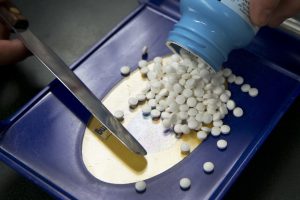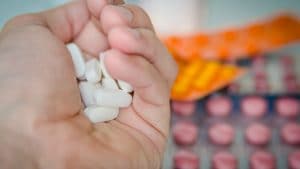Trump takes aim at drug prices but impact on Indian pharma may be minimal

KV Prasad Jun 13, 2022, 06:35 AM IST (Published)
 Listen to the Article (6 Minutes)
Listen to the Article (6 Minutes)
Summary
American president Donald Trump is likely to finally deliver that much delayed speech on bringing down prescription drug prices in the US. The speech will be watched with bated breath by pharma companies. High drug prices were a key issue that Trump addressed during his campaign in 2016. Remember his famous quote in January 2017: …
Continue reading “Trump takes aim at drug prices but impact on Indian pharma may be minimal”
American president Donald Trump is likely to finally deliver that much delayed speech on bringing down prescription drug prices in the US.
The speech will be watched with bated breath by pharma companies. High drug prices were a key issue that Trump addressed during his campaign in 2016.
Remember his famous quote in January 2017: “Pharma companies are getting away with murder.” It sent pharma stocks tumbling down.
While the drug regulator USFDA has been stepping on the gas to reduce generic prices in the US, little has been done by the Trump administration.
Hence, given that this speech would be the first by Trump on prescription drug prices and given his bold moves on other issues, the street is understandably nervous.
Close Watch On Prices
However, if reports hold true, pharma companies both in the US and India should not fret much.
Trump is likely to focus on bringing down drug prices in the US by raising prices of the US manufactured innovative or branded drugs sold in foreign countries, especially the developed ones.
To give you an idea, as of 2015, US spending on pharma was above $1,000 per person, or 30-190% higher than developed counterparts such as Australia, Canada, France, Germany and the UK, among others.
The governments of these countries employ some form of price controls. For example, the UK, which has some of the lowest drug prices among developed countries, runs a government program named National Health Service, or NHS.
The NHS provides free healthcare and hence is one of the world’s biggest buyers of medicines. Such purchasing capacity gives the country greater negotiating power with drug companies.
Trump doesn’t seem to like this. The view of the US administration is that American companies spend on R&D, create new drugs, which are then protected by patents, and sell at exorbitant costs in the US to cover their costs.
But that is not the case in other countries. Due to existing government policies, these countries access the same innovative, patent-protected drugs at cheaper prices. This limits US companies from investing further in R&D and crimps their ability to lower prices in the domestic market.
Further evidence of the Trump administration’s rumination on the subject is provided in a February 2018 report by the White House.
“United States both conducts and finances much of the biopharmaceutical innovation that the world depends on, allowing foreign governments to enjoy bargain prices for such innovations.
This indicates that our current policies are neither wise nor just. Simply put, other nations are free-riding, or taking unfair advantage of the United States’ progress in this area,” the report says.
Though other issues might be highlighted, it seems most likely Trump’s will focus on correcting this long-existing anomaly.
While one cannot entirely rule out Trump focusing on bringing down prices of generic drugs, the fallout is expected to be mild or unlikely. Why? Because measures have already been undertaken to reduce generic prices and the impact is visible. Also, companies selling generic drugs in India and globally are hurting.
For example, Israel’s Teva, the largest manufacturer of generic drugs, is planning to slash its generic portfolio by 80% in the US and aggressively slash costs. Mylan of the US had its North American sales fall 19% due to declining sales of its key drug Epipen as well as price pressure.
Novartis’ Sandoz generic business is up for sale, with sales of the generic unit falling 18% year-on-year this past quarter.
Generic prices in the US have declined by an average of 30% in the past two years.
However, the extent of price reduction in a drug varies based on competition, with a fall of 5-10% in one drug to up to 80% in another. The reason is increased competition.
And the USFDA is taking measures to ensure generic competition increases. In 2017 for example, the USFDA approved a record number of generic drugs – 1,027 in total with over 800 final drug approvals. And analysts only expect this trend of increasing nods with shortening approval times to continue.

Indian Companies Should be Safe
So, net-net what is the impact on Indian companies if Trump sticks to prescription branded drugs sold at lower prices in mostly developed countries? Fortunately, not much.
Indian pharma companies such as Sun Pharma, Lupin, Dr Reddy’s and others have a dominant presence in the generic US market.
India comprises of 30% of the volume of the generic market in the US and 10% in value of the $70-80 billion US generic market.
Hence, while Indian companies should be innovating and creating prescription drugs, it could be fortunate that they are not in this case. Having said that, we are watching this space very closely for any rabbits from Trump’s hat.
Ekta Batra is an anchor and associate editor, research at CNBCTV18. She has been tracking pharma and healthcare for almost a decade.

Elon Musk forms several ‘X Holdings’ companies to fund potential Twitter buyout
3 Mins Read
Thursday’s filing dispelled some doubts, though Musk still has work to do. He and his advisers will spend the coming days vetting potential investors for the equity portion of his offer, according to people familiar with the matter

KV Prasad Journo follow politics, process in Parliament and US Congress. Former Congressional APSA-Fulbright Fellow










 Listen to the Article
Listen to the Article  Daily Newsletter
Daily Newsletter










